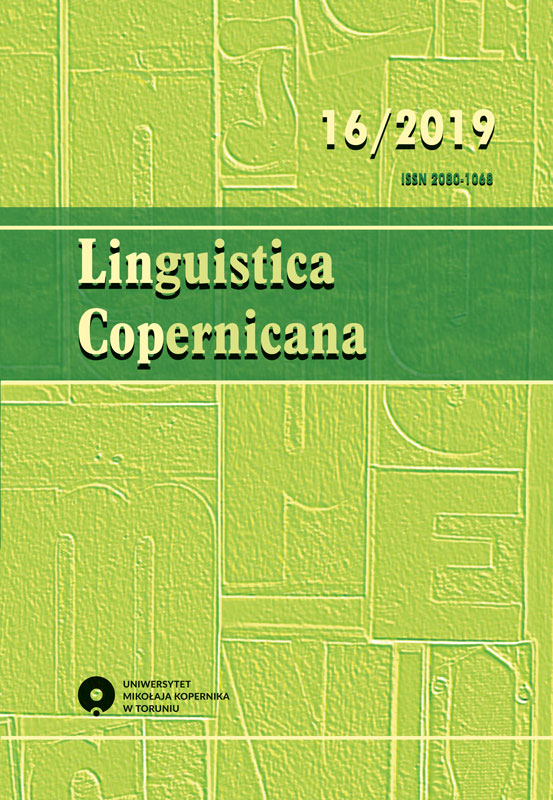Corpus-based analysis of explicitness and implicitness of the (meta)text
DOI:
https://doi.org/10.12775/LinCop.2019.004Keywords
corpus-based studies, discourse relations, discourse markers, connectives, particles, explicitness, implicitnessAbstract
The article analyzes differences in the description of discourse relations in corpus research, in particular with the reference to the use of discourse markers – expressions that tie together subsequent fragments of the text and provide information about the nature of these relations. The text presents three concepts of the description of explicitness and implicitness of the content: Rhetorical Structure Theory, Penn Discourse Treebank and the author’s original proposal and indicates the consequences of each solution. The analysis of relations with particles as metatexual expressions defined in accordance with The Nest Dictionary of Polish reveals the possibility of expressing explicitness as a representation of elements of informational structure shaped by the use of a given particle, and implicitness as a lack of representation of certain elements of this type.
References
Bach K., 1994a, Semantic Slack: What is Said and More, w: S. Tsohatzidis (red.), Foundations of Speech Act Theory, London: Routledge, s. 267–291.
Bach K., 1994b, Conversational Implicature, Mind and Language 9, s. 124–162.
Carlson L., Marcu D., 2011, Discourse Tagging Reference Manual, [online:] https://www.isi.edu/~marcu/discourse/tagging-ref-manual.pdf.
Celle A., Huart R. (red.), 2007, Connectives as Discourse Landmarks, Amsterdam/Philadelphia: John Benjamins.
Das D., Taboada M., 2018, RST Signalling Corpus: A corpus of signals of coherence relations, Language Resources and Evaluation 52 (1), s. 149–184.
Dijk T. A., 1981, Studies in the Pragmatics of Discourse (Vol. 101), Berlin: Walter de Gruyter.
Dijk T. A., 2001, Dyskurs jako struktura i proces, Warszawa: Wydawnictwo Naukowe PWN.
Duszak A., 1998,: Tekst, dyskurs, komunikacja międzykulturowa, Warszawa: PWN.
Fraser B., 1999, What are discourse markers?, Journal of Pragmatics 37, s. 931–952.
Fraser B, 2006, Towards a theory of discourse markers, w: K. Fisher (red.), Approaches to Discourse Particles, Amsterdam: Elsevier, s. 189–204.
Grochowski M., 1976a, Elipsa, kondensacja a interpretacja semantyczna, Sborník Prací Filosofické Fakulty Brněnské University, A 24, s. 67–71.
Grochowski M., 1976b, O pojęciu elipsy, Pamiętnik Literacki LXVII, 1, s. 121–136.
Grochowski M. (1978): Czy zjawisko elipsy istnieje?, w: M. R. Mayenowa (red.), Tekst. Język. Poetyka. Zbiór studiów, Wrocław: Ossolineum, s. 73–85.
Grochowski M. (red.), 1995, Wyrażenia funkcyjne w systemie i tekście, Toruń: UMK.
Grochowski M., 1997, Wyrażenia funkcyjne. Studium leksykograficzne, Kraków: IJP PAN.
Grochowski M., Kisiel A., Żabowska M., 2014, Słownik gniazdowy partykuł polskich, Kraków: Wydawnictwo Polskiej Akademii Umiejętności.
Grzmil-Tylutki H., 2000, Francuski i polski dyskurs ekologiczny w perspektywie aksjologii, Kraków: Wydawnictwo UJ.
Hall A., 2007, Do discourse connectives encode procedures or concepts?, Lingua 117, s. 149–174.
Hawley P., 2002, What is said, Journal of Pragmatics 34 (8), s. 969–991.
Klemensiewicz Z., 1953, Zarys składni polskiej, Warszawa: Państwowe Wydawnictwo Naukowe.
Lewandowska-Tomaszczyk B. (red.), 2005, Podstawy językoznawstwa korpusowego, Łódź: Wydawnictwo Uniwersytetu Łódzkiego.
Mann W. C., Thompson S. A., 1988, Rhetorical Structure Theory: Toward a Functional Theory of Text Organization, Text 8 (3), s. 243–281.
Norrick N. R., 2001, Discourse and Semantics, w: D. Schiffrin, D. Tannen, H. E. Hamilton (red.), The Handbook of Discourse Analysis, Blackwell Publishing, s. 76–99.
Nowak T., 2013, Od przesłanki do konkluzji. Polskie czasowniki wnioskowania, Katowice: Wydawnictwo Uniwersytetu Śląskiego.
O'Donnell M., 2008, The UAM CorpusTool: Software for corpus annotation and exploration, w: B. Callejas, M. Carmen et al. (red.), Applied Linguistics Now: Understanding Language and Mind / La Lingüística Aplicada Hoy: Comprendiendo el Lenguaje y la Mente, Almería: Universidad de Almería, s. 1433–1447.
Ogrodniczuk M., Głowińska K., Kopeć M., Savary A., Zawisławska M., 2015, Coreference in Polish: Annotation, Resolution and Evaluation, Berlin: Walter De Gruyter.
Prasad R., Webber B., Joshi A., 2014, Reflections on the Penn Discourse TreeBank, Comparable Corpora and Complementary Annotation, Computational Linguistics 40 (4), s. 921–950.
Récanati F., 2001, What Is Said, Synthese 128 (1–2), s. 75–91.
Schiffrin D., 1987, Discourse Markers, Cambridge: Cambridge University Press.
Schiffrin D., 2001, Discourse Markers: Language, Meaning, and Context, w: D. Schiffrin, D. Tannen, H. E. Hamilton (red.), The Handbook of Discourse Analysis, Blackwell Publishing, s. 54–75.
Sperber D., Wilson D., 1995, Relevance. Communication and cognition, Oxford: Blackwell Publishing.
Synowiec A., 2013, W stronę analizy tekstu – wprowadzenie do teorii dyskursu, Zeszyty naukowe Politechniki Śląskiej, Seria: Organizacja i zarządzanie, z. 65, s. 383–396.
Taboada M., 2009, Implicit and Explicit Coherence Relations, w: J. Renkema (red.), Discourse, of Course, Amsterdam/Philadelphia: John Benjamins, s. 127–140.
Taboada M., Das D., 2013, Annotation upon annotation: Adding signalling information to a corpus of discourse relations, Dialogue and Discourse 4 (2), s. 249–281.
Wajszczuk J. (2005): O metatekście. Warszawa: Katedra Lingwistyki Formalnej.
Ward G., Birner B. J. (2001): Discourse and Information Structure, w: D. Schiffrin, D. Tannen, H. E. Hamilton (red.), The Handbook of Discourse Analysis, Blackwell Publishing, s. 119–137.
Webber B., Egg M., Kordoni V., 2012, Discourse Structure and Language Technology, Natural Language Engineering 18 (4), October 2012, s. 437–490.
Wierzbicka A., 1971, Metatekst w tekście, w: M. R. Mayenowa (red.), O spójności tekstu, Wrocław: Ossolineum, s. 105–121.
Wójcicka A., 2016, Mówienie i dawanie do zrozumienia. Studium semantyczne czasowników komunikacji niebezpośredniej, Warszawa: Katedra Lingwistyki Formalnej UW.
Downloads
Published
How to Cite
Issue
Section
Stats
Number of views and downloads: 1314
Number of citations: 0



